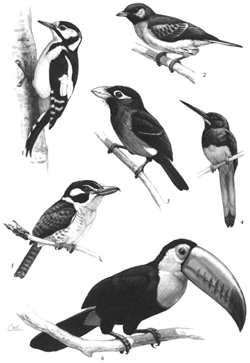Woodpeckers and Allies: Order Piciformes
The Order Piciformes comprises nine varied families, of which the Picidae (woodpeckers) is the largest. All piciform birds have zygodactyl feet and a unique arrangement of tendons in the toes.
The families differ most obviously in the shape of the bill: it is strong, sturdy, and chisel-like in woodpeckers, wrynecks, and piculets; long, slender, and sharply pointed in jacamars; stout, anteriorly compressed, and somewhat decurved at the tip in puffbirds; stout, more or less conical, and surrounded by bristles in barbets; small and slightly hooked in honeyguides; and very large and inflated in toucans.
Piciform birds have diverse feeding specializations. Woodpeckers hitch up vertical tree trunks and chip wood and bark with their chisel-like bills. Long, barb-tipped tongues enable them to extract woodboring insects from tiny crevices. Jacamars catch butterflies on the wing. Puffbirds pluck large caterpillars from tropical foliage. Barbets and toucans consume much fruit, but toucans also snatch eggs and young from the nests of other birds. Some honeyguides eat beeswax and bee larvae, which they obtain by leading humans and honeybadgers to natural beehives.
All species nest in holes, or cavities. The young are naked and blind at hatching.Honeyguides are also specialized brood parasites that lay their eggs in the nests of woodpeckers, barbets, and other birds.
The true woodpeckers have stiffened tail feathers that serve as a prop when the bird is clinging to a tree. Color and pattern vary, from the dull greens of some honeyguides and the black-and-white patterns of woodpeckers to the brilliant reds, blues, and yellows of many barbets and toucans. The sexes are generally similar, but among the woodpeckers the males often have patches of red on the head that are reduced or absent in females.

Figure A–25 Woodpeckers and allies: (1) Great Spotted Woodpecker (Picidae); (2) Greater Honeyguide (Indicatoridae); (3) Double-toothed Barbet (Ramphastidae); (4) White-chinned Jacamar (Galbulidae); (5) White-eared Puffbird (Bucconidae); (6) Keel-billed Toucan (Ramphastidae).